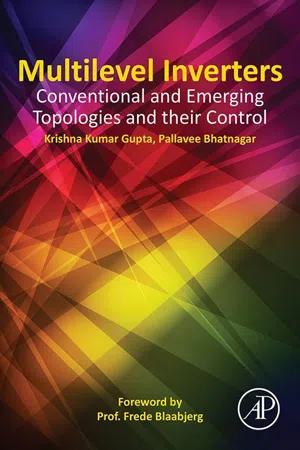
Multilevel Inverters
Conventional and Emerging Topologies and Their Control
- 228 pages
- English
- ePUB (mobile friendly)
- Available on iOS & Android
Multilevel Inverters
Conventional and Emerging Topologies and Their Control
About This Book
Multilevel Inverters: Conventional and Emerging Topologies and Their Control is written with two primary objectives: (a) explanation of fundamentals of multilevel inverters (MLIs) with reference to the general philosophy of power electronics; and (b) enabling the reader to systematically analyze a given topology with the possibility of contributing towards the ongoing evolution of topologies. The authors also present an updated status of current research in the field of MLIs with an emphasis on the evolution of newer topologies. In addition, the work includes a universal control scheme, with which any given topology can be modulated. Extensive qualitative and quantitative evaluations of emerging topologies give researchers and industry professionals suitable solutions for specific applications with a systematic presentation of software-based modeling and simulation, and an exploration of key issues.
Topics covered also include power distribution among sources, voltage balancing, optimization switching frequency and asymmetric source configuration. This valuable reference further provides tools to model and simulate conventional and emerging topologies using MATLAB®/Simulink® and discusses execution of experimental set-up using popular interfacing tools.
The book includes a Foreword by Dr. Frede Blaabjerg, Fellow IEEE, Professor and VILLUM Investigator, Aalborg University, Denmark.
- Includes a universal control scheme to help the reader learn the control of existing topologies and those which can be proposed in the future
- Presents three new topologies. Systematic development of these topologies and subsequent simulation and experimental studies exemplify an approach to the development of newer topologies and verification of their working and experimental verification.
- Contains a systematic and step-by-step approach to modelling and simulating various topologies designed to effectively employ low-power applications
Frequently asked questions
Information
Basics of Inverters
Abstract
Keywords
1.1 Introduction
1.2 Power Electronics as a Technology


Table of contents
- Cover image
- Title page
- Table of Contents
- Copyright
- Dedication
- Foreword
- About the Authors
- Preface
- Acknowledgments
- Chapter 1. Basics of Inverters
- Chapter 2. Basics of Multilevel Inverters
- Chapter 3. Advent of New Topologies
- Chapter 4. Universal Control Scheme with Voltage-Level-Based Methods
- Chapter 5. Multilevel Inverter Based on Bridge-Type Connected Sources
- Chapter 6. Cross-Connected Sources-Based Multilevel Inverter
- Chapter 7. Comparison of Multilevel Inverter Topologies
- Index